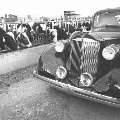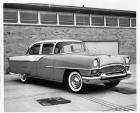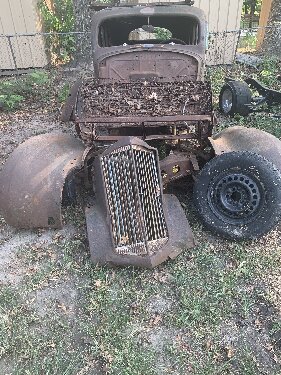|
Re: Exhaust manifold leaking
|
||||
|---|---|---|---|---|
|
Forum Ambassador

|
I'd certainly add one step.
After removal of the manifold set, check all the contacting surfaces from one end to the other with a long flat edge (or have a machine shop do it for you). It's not at all uncommon for exhaust flanges to warp; if so have them resurfaced as an assembled set sufficient to give a completely flat surface to present to the gaskets and engine block. Otherwise you may just run the risk of loosing another gasket and repeating the job. And when you reinstall, remember that you have different expansions between the individual manifolds and the block itself as they have different operating temperatures so there needs to be a bit of freedom of movement between them - so follow the torque specification for the fasteners and use good quality nuts and washers.
Posted on: 2013/7/14 16:38
|
|||
|
||||
|
Re: Exhaust manifold leaking
|
||||
|---|---|---|---|---|
|
Home away from home

|
Thank you for the additional tips O.D. Also, should the manifold donut to head pipe be changed too? I guess that this gasket is a compression fit and it has already been pressed to fit. I'm thinking yes it should be changed too?
Posted on: 2013/7/15 17:55
|
|||
|
Steve
Old cars are my passion  1951 Packard 200 1953 Packard Clipper Custom Touring Sedan 1955 Dodge Custom Royal Lancer Tri-tone 1966 Rambler Classic 770 Convertible |
||||
|
||||
|
Re: Exhaust manifold leaking
|
||||
|---|---|---|---|---|
|
Home away from home
|
OD is absolutely correct, if the manifold assembly machine surface is not flat then a new gasket won't last. If you have a concrete driveway and can confirm a good flat surface on it about twice as long as the manifold, you can true the surface of the by wetting the area of the driveway with soapy water, place the manifold surface on the driveway and then begin rubbing the manifold back and forth over the wet area. You would be surprised at how quickly you can true up exhaust manifolds using this method or combination intake/exhaust manifolds as long as they can lay flat on the drivaway surface.
Posted on: 2013/7/15 19:13
|
|||
|
||||
|
Re: Exhaust manifold leaking
|
||||
|---|---|---|---|---|
|
Home away from home

|
Don't you scratch the living daylight out of the surface of your exhaust manifold on the concrete? Never heard of that method before.
Sounds like a flintstone way to me.
Posted on: 2013/7/16 8:54
|
|||
|
I can explain it to you but I can't understand it for you
 Bad company corrupts good character! Farming: the art of losing money while working 100 hours a week to feed people who think you are trying to kill them |
||||
|
||||
|
Re: Exhaust manifold leaking
|
||||
|---|---|---|---|---|
|
Webmaster
|
Unless you have to, do not disassemble the two manifolds from one another, as that is where you really can get the flange to block surface out of square.
Posted on: 2013/7/16 10:57
|
|||
|
-BigKev
1954 Packard Clipper Deluxe Touring Sedan -> Registry | Project Blog 1937 Packard 115-C Convertible Coupe -> Registry | Project Blog |
||||
|
||||
|
Re: Exhaust manifold leaking
|
||||
|---|---|---|---|---|
|
Forum Ambassador

|
For Pete's sake! Take it to a machine shop and have it done properly!!!
I would have used a different expletive but Kev would rap my knuckles.
Posted on: 2013/7/16 11:00
|
|||
|
||||
|
Re: Exhaust manifold leaking
|
||||
|---|---|---|---|---|
|
Home away from home
|
Quote:
Its called being creative...its what people did years ago when the nearest city with a machine shop was a hundred miles away...considering the fact that machine surfacing is accomplished by one of two methods, tool bit or wet stone then wetting concrete and hand surfacing the manifold is no different than resurfacing via the wet stone method. I worked in the automotive machining business for many years and just by luck learned a thing or two about resurfacing machined mating surfaces and as archaic as it may sound, the method works...I said you would be surprised at how easy it is...anyone familiar with big block ford 352, 390, 360 etc. V8 engines knows that the manifold to head assemblies are cast iron to cast iron from the factory and ultimately the mating surfaces would fail from exposure to the heat. The most recent for me was about 3 years ago when I removed the manifolds from both heads on a '72 F-350 and applied the above method to them...it took about 20 minutes each to true the surfaces. The exhaust manifold side of the heads were still O.K. so after block sanding them, I applied a thin coat of high temp silicone to the mating surfaces, installed the manifolds and today there are still no manifold leaks and guess what?...I didn't have to withdraw a single dime from hip pocket national bank and it didn't damage the driveway one bit either but if you have plenty of money the machine shop will be glad to take it... geez...
Posted on: 2013/7/17 19:40
|
|||
|
||||








